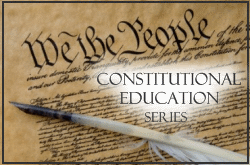 It’s important that we educate our children on the topics of politics, government, and the Constitution which governs our nation. This nine-part series attempts to remind us of some basic principles, lest they be forgotten by the next generation.
It’s important that we educate our children on the topics of politics, government, and the Constitution which governs our nation. This nine-part series attempts to remind us of some basic principles, lest they be forgotten by the next generation.The word “secession” has taken on a negative connotation today. The idea of at state refusing to abide by the rules imposed by the federal government and deciding to govern itself entirely – the very definition of the word “secession” – is problematic for most people. After all, we are the United States of America, and we should stay that way regardless of the consequences, right?
Nullification is similar to secession in that it is the refusal of a state to accept a law handed down by a federal authority. It is like secession, but without the final step of complete separation from the overall entity. We hear little about the concept of secession, and most students today would reject the possibility of a state even considering the refusal to obey a federal statute.
You may be surprised, then, to learn that secession and nullification were accepted practices in the days of the founding fathers. Indeed, the decision by the thirteen states to declare independence from the English monarchy has been referred to as being more like a secession than an actual revolution. These states decided to forego the rules and oversight of the king of England and live by their own standards and government. On the topic of secession, Thomas Jefferson (the author of the Declaration of Independence) said in his first inaugural address of 1801, “If there be any among us who wish to dissolve the Union or to change its republican form, let them stand undisturbed, as monuments of the safety with which error of opinion may be tolerated where reason is left free to combat it.” Both Jefferson and James Madison wrote on the topic of nullification, saying, “where powers were assumed by the national government which had not been granted by the states, nullification is the rightful remedy," and that every state has a right to "nullify of its own authority all assumptions of power by others. . ." Strong words!
Even Abraham Lincoln said in an 1848 speech that, “Any people whatsoever have the right to abolish the existing government, and form a new one that suits them better. This is a most valuable, a most sacred right.” And yet, in his inaugural address in 1861, Lincoln implied that the sovereignty of the Union outweighed that of the individual states and that, in this matter, the Constitution actually abridged the founders’ intent! And on this platform, he denied the rights of the Southern states who had seceded from the Union, and invaded them with the Northern army. At one point, eleven States officially seceded, in this order – South Carolina, Mississippi, Florida, Alabama, Georgia, Louisiana, Texas, Virginia, Arkansas, North Carolina, and Tennessee.
Horace Greeley, the preeminent newspaperman, chronicled this period in history. In 1861, he wrote that "nine out of ten people of the North were opposed to forcing South Carolina to remain in the Union" for "the great principle embodied by Jefferson in the Declaration . . . is that governments derive their just power from the consent of the governed." If the southern states wanted to secede, Greeley maintained that most people agreed "they have a clear right to do so."
In a world today which prizes unity, even in situations where it does not fit, the idea of secession appears to be backwards and immature. Yet, the founders supported the idea for one certain reason – the power of individual states should always outweigh that of the central government. Unlike the behavior of today’s government, our forefathers saw the “power pyramid” as being upside-down from how we would perceive it. To them, it was individuals at the top, states next, and the federal government at the bottom of the heap. The very threat of secession was often enough to keep the federal government in check, and the balance of power well-distributed. Many may preach that unity is paramount, but the idea of secession also serves as a deterrent to unlimited federal power. Frank Chodorov wrote in 1952: "If for no other reason, personal pride should prompt every governor and state legislator to take a secessionist attitude; they were not elected to be lackeys of the federal bureaucracy." Which would you rather have – a loose conglomeration of independent states trying to preserve individual freedoms, or a dictating federal monarchy that reduces all of the states to the lowest common denominator?
Curiously, a 2008 Zogby International poll showed that 22% of Americans believe that “any state or region has the right to peaceably secede and become an independent republic.”
Search the Constitution and you will not find the words “secession” or “nullification”. But it is clear from the many writings of the founders that they would support the idea. Indeed, they acted it out when they signed the Declaration of Independence in 1776. “When in the Course of human events, it becomes necessary for one people to dissolve the political bands which have connected them with another…”
Next article: What are “enumerated powers” versus “implied powers” in the Constitution? Back to the main index article.











1 comment:
chenlina20160527
michael kors handbags
coach factory outlet online
nike store outlet
nike roshe run women
adidas shoes
christian louboutin outlet
louis vuitton handbags
hollister clothing
fitflop sandals
ray bans
oakley canada
louis vuitton outlet
jordan concords
supra sneakers
hollister clothing
ray ban sunglasses
louis vuitton
louis vuitton handbags
oakley sunglasses
hollister kids
true religion outlet
asics outlet
vans shoes sale
longchamp outlet
gucci outlet
ray ban sunglasses
polo ralph lauren
true religion outlet
louis vuitton outlet
kobe 9
ray ban sunglasses
jeremy scott shoes
ray bans
louis vuitton outlet
kate spade handbags
nike factory outlet
gucci handbags
fitflops
abercrombie outlet
fake watches
as
Post a Comment